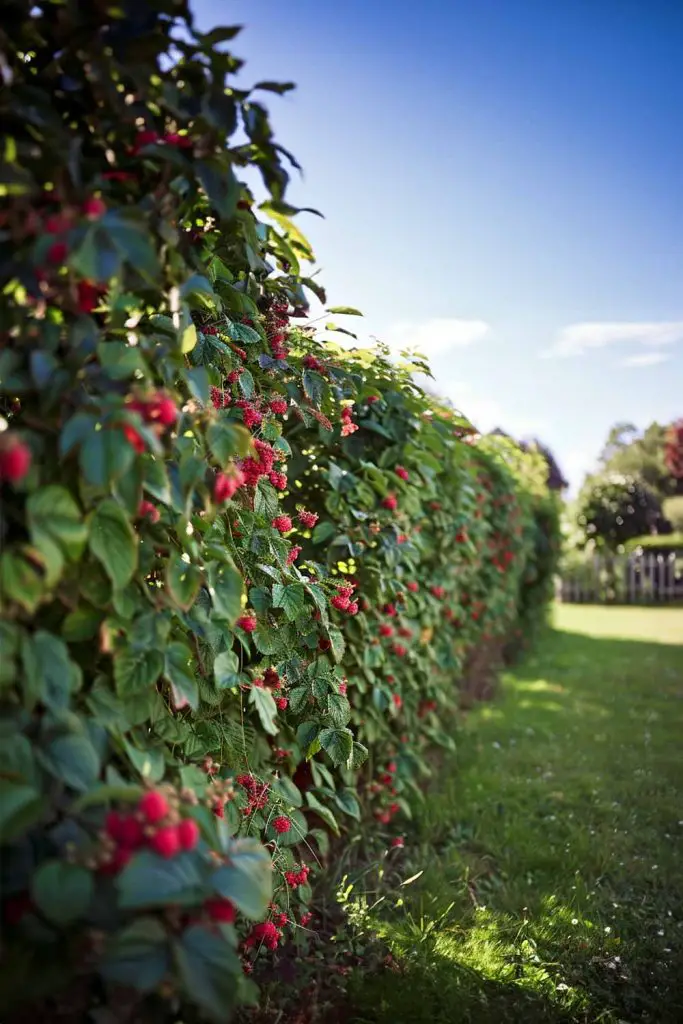What Should You Plant To Make Your Own Edible Hedge!

Creating an edible hedge is a delightful way to combine beauty and functionality in your garden. Not only will it provide privacy and habitat for wildlife, but it will also supply you with delicious fruits, nuts, and herbs. In this guide, we’ll explore nine fantastic plants you can use to create your own edible hedge and provide detailed care instructions to ensure your hedge thrives.
Blueberry Bushes: Sweet and Nutritious
Planting: Blueberries are a fantastic choice for an edible hedge. They require acidic soil (pH 4.5-5.5) and plenty of sun. Plant them about 3-4 feet apart to allow enough space for growth.
Care: Water regularly, especially during dry periods. Mulch with pine needles or acidic compost to maintain soil acidity. Prune in late winter to remove old or dead wood.
Raspberry Canes: Tart and Tasty
Planting: Raspberries prefer well-draining, slightly acidic soil. Plant the canes 18-24 inches apart in rows 8-10 feet apart. Ensure they get full sun for the best fruit production.
Care: Water deeply once a week. Prune annually, cutting back old canes after they have fruited. Use a trellis or support system to keep the canes upright.
Blackberry Bushes: Juicy and Robust
Planting: Blackberries thrive in slightly acidic to neutral soil and full sun. Plant them 3-6 feet apart in rows spaced 8 feet apart.
Care: Water consistently, especially during the growing season. Prune in late winter, removing old canes that have fruited and training new canes onto a support system.
Goji Berries: Superfood Powerhouse
Planting: Goji berries prefer well-draining soil and full sun. Plant them 3-5 feet apart. They are tolerant of various soil types but prefer slightly alkaline conditions.
Care: Water regularly but avoid waterlogging. Prune in early spring to shape the plant and remove dead wood. Fertilize annually with compost or balanced fertilizer.
Hazelnut Shrubs: Nutty and Nutritious
Planting: Hazelnuts need well-draining soil and full sun to partial shade. Plant them 15-20 feet apart, as they can grow quite large.
Care: Water young plants regularly. Mulch to retain moisture and suppress weeds. Prune in late winter to maintain shape and remove any diseased branches.
Serviceberries: Versatile and Hardy
Planting: Serviceberries, also known as juneberries, prefer well-draining soil and full sun to partial shade. Plant them 4-6 feet apart.
Care: Water regularly, especially during dry spells. Prune in late winter or early spring to remove dead or crowded branches. Fertilize with compost annually.
Fruiting Quince: Unique and Flavorful
Planting: Quince prefers well-draining, slightly acidic to neutral soil and full sun. Plant them 10-15 feet apart to accommodate their growth.
Care: Water regularly, especially during dry periods. Prune in late winter to shape the tree and remove dead wood. Fertilize in early spring with a balanced fertilizer.
Rugosa Roses: Beautiful and Beneficial
Planting: Rugosa roses are hardy and thrive in well-draining soil with full sun. Plant them 2-3 feet apart to form a dense hedge.
Care: Water regularly, especially during dry spells. Prune after flowering to shape the plant and remove spent blooms. Mulch to retain moisture and suppress weeds.
Pineapple Guava: Exotic and Evergreen
Planting: Pineapple guava, or feijoa, prefers well-draining soil and full sun to partial shade. Plant them 3-5 feet apart for a dense hedge.
Care: Water regularly, especially during dry periods. Prune in late winter or early spring to maintain shape and remove dead wood. Fertilize with a balanced fertilizer in spring.
Creating an edible hedge is a rewarding way to enhance your garden’s beauty and productivity. By carefully selecting and caring for a variety of fruiting and nut-bearing plants, you can enjoy a lush, green barrier that offers both privacy and a bountiful harvest. Happy gardening!

More interesting articles you may be interested in reading:

